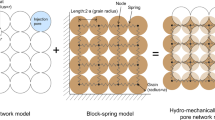Abstract
Fractal networks are widely applied in the field of heat and mass transfer. As one of the important parts of the fractal network, Y-shaped structure definitely has a significant impact on the performance of the whole network. In this paper, the analytical relationship between Y-shaped microchannel geometry and its capillary flow time is established through theoretical analysis with mass continuity equation and Navier-Stokes (N-S) equations. The result reveals that the capillary flow time increases with the increase of the topology length and bifurcation angle of the Y-shaped microchannel, but decreases with the increase of the channel width.
Similar content being viewed by others
References
Han S, Wang K K. Analysis of the flow of encapsulant during underfill encapsulation of flip-chips [J]. IEEE Transactions on Components, Packaging and Manufacturing Technology. Part B: Advanced Packaging, 1997, 20(4): 424–433.
Lai C C, Chung C K. Numerical simulation of the capillary flow in the meander microchannel [J]. Microsyst Technol, 2013, 19(3): 379–386.
Jong W R, Kuo T H, Ho S W, et al. Flows in rectangular microchannels driven by capillary force and gravity [J]. International Communications in Heat and Mass Transfer, 2007, 34(2): 186–196.
Ichikawa N, Hosokawa K, Maeda R. Interface motion of capillary-driven flow in rectangular microchannel [J]. Journal of Colloid and Interface Science, 2004, 280(1): 155–164.
Erickson D, Li D, Park C B. Numerical simulations of capillary-driven flows in nonuniform cross-sectional capillaries [J]. Journal of Colloid and Interface Science, 2002, 250(2): 422–430.
Young W B. Analysis of capillary flows in nonuniform cross-sectional capillaries [J]. Colloids and Surfaces A: Physicochemical and Engineering Aspects, 2004, 234(1): 123–128.
Xu P, Yu B M, Feng Y J, et al. Analysis of permeability for the fractal-like tree by parallel and series models [J]. Physica A: Statistical Mechanics and Its Applications, 2006, 369(2): 884–894.
Xu P, Yu B M, Qiu S X, et al. An analysis of the radial flow in the heterogeneous porous media based on fractal and constructal tree networks [J]. Physica A: Statistical Mechanics and Its Applications, 2008, 387(26): 6471–6483.
Yu B M, Li B W. Fractal-like tree networks reducing the thermal conductivity [J]. Physical Review E, 2006, 73(6): 66302.1–8.
Chen T, Gong S C, Xiao Y. Investigation of bifurcation structure flow field for bipolar plates in PEMFC [J]. Heat Mass Transfer, 2013, 49(2): 147–153.
Peng Y, Liu W Y, Wang N L, et al. A novel wick structure of vapor chamber based on the fractal architecture of leaf vein [J]. International Journal of Heat and Mass Transfer, 2013, 63: 120–133.
Murray C D. The physiological principle of minimum work. I. The vascular system and the cost of blood volume [J]. Proceedings of the National Academy of Sciences of the United States of America, 1926, 12(3): 207–214.
Mehrabian H, Gao P, Feng J J. Wicking flow through microchannels [J]. Physics of Fluids, 2011, 23(12): 122108.1–14.
Author information
Authors and Affiliations
Corresponding author
Additional information
Foundation item: the National Natural Science Foundation of China (No. 51375169)
Rights and permissions
About this article
Cite this article
Liu, Wy., Chen, W., Peng, Y. et al. Influence of the unit Y-shaped microchannel geometry on the capillary flow. J. Shanghai Jiaotong Univ. (Sci.) 20, 443–448 (2015). https://doi.org/10.1007/s12204-015-1646-3
Received:
Published:
Issue Date:
DOI: https://doi.org/10.1007/s12204-015-1646-3




